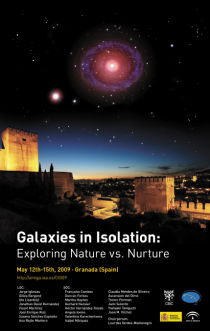Topics The main aspects to be addressed during this meeting are:
Isolated galaxies: definition and detection strategies The selection criteria used to define a sample of galaxies are determinant for the results to be obtained, since from them depend the biases that the resulting sample will suffer. This is usually at the origin of the different results obtained for, apparently, similar samples. Isolated galaxies, as a reference to understand the effects of gravitational interactions, should hence be carefully selected in order to minimize nurture effects. Not only the definition of the sample is relevant, but also the detection strategies where minimizing e.g. incompleteness effects relies on. How should an isolated galaxy be selected? How can this limited by the observational data? Statistical and individual properties of isolated galaxies Numerous studies of isolated galaxies exist so far. While their global properties provide a reference level for e.g. their star formation, nuclear activity, or stellar populations among others, to which interacting samples can be compared, the details of their structural as well as dynamical properties give insight on the physical origin of the numerous perturbations usually associated to interactions. How does the global emission of galaxies compare with interacting samples? Are e.g. bars, warps or rings found more frequently in denser environments? The void problem Regions between clusters, filaments and walls have been found by galaxy redshift surveys to be nearly devoid of galaxies. This was emphasized by J. Peebles as a possible challenge to the current galaxy formation models. It is well known that galaxy properties depend strongly on their environment.Are galaxies in these underdense regions mostly influenced by their local environment or by the underdense region where they reside? Modelling and observations at different lookback times The study of high-z systems experiences rapid expansion. But what are isolated local galaxies in the context of high-z studies? If galaxies are built hierarchically, those selected to be isolated their entire lives could be true or quasi-primordial systems, hence shedding light on the early stages of galaxy formation. Questions like at what epoch was the morphology-density relation imprinted, or whether there were isolated galaxies at all epochs will be addressed in this topic. Pairs and compact groups vs Isolated galaxies: nurture in action? The most common reference or control samples found in the literature can be described as either 'field' or 'normal'. A 'field' sample might include any galaxy not belonging to a cluster, so that galaxies in pairs, triplets and loose/compact groups would not necessarily be excluded. 'Normal' galaxies refer to those showing none of the generally accepted signs of interaction-induced activity. The alternative approach involves sample selection using an isolation criterion. In this way samples of isolated galaxies are complemented by catalogs of isolated pairs, triplets and compact groups. None of these samples take into account more hierarchical systems, so that this likely reduces the interaction equation to the effects of one-on-one encounters. What are the signs of one-on-one interactions? How are star formation, nuclear activity, or structural changes (e.g. warps, rings, etc.) conditioned by the local environment in isolated systems, when compared with isolated galaxies? Modelling nature versus nurture While many interaction effects have been well reproduced by modelling, is theory able to distinguish natural properties from nurturing effects? It seems clear that gross asymmetries, bridges, strong bars or tails are nurture effects. But are there natural bars, and are they destroyed by nurture? The same question is still open for e.g. bulges. Are all true bulges likely nurtured and pseudobulges natural? What is the origin of the low luminosity E and S0 isolated galaxies?. The future: isolated galaxies and new facilities In this topic we would like to place isolated galaxies in a broader temporal context, exploring how their study can benefit from next generation facilities, both including observations and new powerful developments available for astronomy in the e-science context. |
 |





